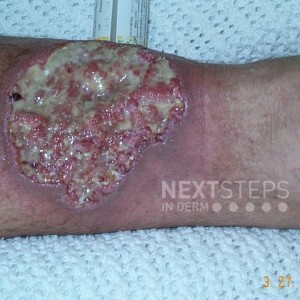
The correct answer is B. IgA.
The image, along with the vignette, describes Pyoderma gangrenosum (see image Figure 2.1.39 in DIR). This condition is more common in women and 50% of cases are associated with an underlying systemic disease including Crohn’s, ulcerative colitis, rheumatoid arthritis, hematologic conditions (including IgA monoclonal gammopathy), infections, and others. Often, trauma precedes these lesions, and there are several subtypes (ulcerative, vesiculobullous, pustular, and vegetative). Treatment of underlying disease is crucial, but other therapies include topical steroids or intralesional steroids, or systemic agents (systemic steroids, cyclosporine, anti-tumor necrosis factor (TNF)-α, sulfapyridine, sulfasalazine, dapsone, mycophenolate mofetil, methotrexate, azathioprine, minocycline, thalidomide, saturated solution of potassium iodide (SSKI), azathioprine, cyclophosphamide, chlorambucil, and clofazimine).
a. IgE is not commonly associated with pyoderma gangrenosum
b. IgA is the correct answer. Other associations include EED, subcorneal pustular dermatosis, IgA pemphigus, POEMS, and Sweet’s syndrome c. IgM is associated with Schnitzler syndrome and Waldenström macroglobulinemia
d. IgG is associated with NXG (IgGκ), scleredema (IgGκ > IgGλ), scleromyxedema (IgGλ > IgGκ)
e. IgD is not commonly associated with pyoderma gangrenosum
References:
Medical Dermatology chapter, 2.1 Neutrophilic Disorders, DIR Review book page 77. 2020
